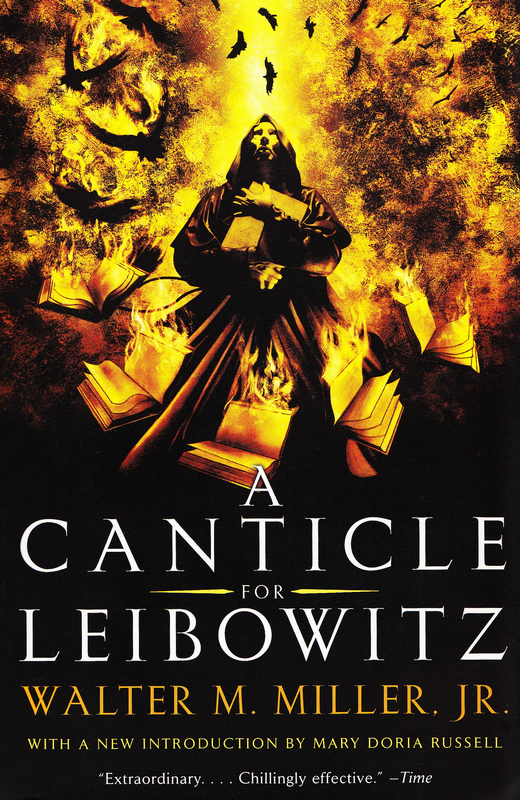
This sprawling, intricate post-apocalyptic novel blends religious faith with science fiction, and envisions a potential course for human civilisation that’s both bleak and hopeful – and surprisingly humorous. It’s a wonderfully written book deserving of its classic status.
Published in 1959, A Canticle for Leibowitz is one of the many works of science fiction born in the shadow of nuclear weapons and fears of a catastrophic global war that still linger today. This novel stood out to me for its Catholic aspect, as its centuries-spanning story is set in the same Roman Catholic monastery located somewhere in the desert of Utah. There might well be other religious post-apocalyptic novels out there, but as I haven’t come across any it definitely felt unique.
I didn’t know this when I started the book, but Canticle is broken into three time periods, each set roughly 600 years from each other. The first part takes place in the 26th century, generations after nuclear holocaust – or Flame Deluge as it’s referred to in a more evocative biblical language – has scoured the earth. What’s left of humanity is scattered around in loose settlements here and there, with no central government or any surviving institutions left, save for the Catholic Church.
The story begins with a young monk named Francis, who belongs to the Albertian Order of Leibowitz. Isaac Leibowitz, we find out, was a 20th century electrical engineer who, after surviving the war, joined the church and founded an order dedicated to the preservation of books and knowledge during the Dark Age following the nuclear apocalypse. While out in the desert on his lonely Lenten vigil, Francis uncovers an old fallout shelter, containing relics belonging to Blessed Leibowitz that might finally pave the way for him to be officially declared a Saint.
Fast forward six centuries, and humanity, now organised in feudal city states ruled by powerful warlords, is finally ready for a second Renaissance. The middle part centres mostly on the growing tensions between secular science and the Church, and their differing views on what should be done with the preserved texts from the past civilisation. The last section jumps to the 38th century, where humanity is once again at the peak of its technological brilliance, but hasn’t shed any of those pesky self-destructive instincts in the process. A war is brewing, and the Order of Leibowitz must reach out to the stars if it’s to preserve the human knowledge as well as the Church itself.
Miller’s bleak view of the cyclical nature of history is certainly a downer, though the novel’s strong Christian spirit means that it never fully gives into despair and always preserves a comforting spark of hope. No matter how brutal and pessimistic things get, the writing remains light, often playful and ironic. Humour, including moments of true pitch-black gallows humour, is one of the most memorable aspects of the book. Many characters here die horribly, but even then Miller manages to weave in something uplifting or darkly comical or both.
Canticle is a kind of grand science fiction novel mostly concerned with Ideas rather than characters or plot. The narrative is episodic and the time skips across vast swathes of time create a certain emotional distance. I admit, I felt utterly disoriented when the first part was over and you had to quickly adjust to the brand new characters as you’re unceremoniously thrown into the next time period. By the end, I did appreciate the ambition and scale and really felt like I have travelled across 1,200 years of human history.
I also loved Miller’s world-building, even if the settings of second Renaissance and futuristic humanity don’t feel quite as vividly realised and lived in as the savage, dirt-eating world inhabited by Francis. There’s also a predictable effect of future technology as imagined in the late 1950s feeling dated and naive. Speaking of Francis, he might be the novel’s most engaging protagonist despite his simple, bumbling nature, or maybe because of it. In a novel full of intellectual, philosophising characters, he’s the closest thing to an everyman.
The book is loaded with complex themes and weighty, sometimes provocative moral ideas: the value and danger of knowledge, the rift between Church and State, euthanasia and the right to live, the essential hollowness of a society that elevates comfort, safety and material well-being above everything else. It’s not afraid to take a stance on certain issues that might feel confronting or off-putting to the readers, but it does a good job making a compelling case and having other characters challenge and question it.
My personal feelings about the Catholic Church in the real world are… fairly mixed shall we say, but in this book it is very much a force for good. It’s not above some petty politicking among the factions, and the various monks and abbots you encounter along the way are not perfect individuals, but you’re ultimately left with an impression of decent, flawed people trying to do their best in a chaotic world. I admired the quiet dedication to the preservation of texts and documents, without comprehending their meaning or knowing if their efforts will ever amount to anything.
It feels impossible to describe all aspects of the novel without making this review twice as long; I haven’t even mentioned the touch of magical realism in the shape of Benjamin, a seemingly immortal Jewish hermit who haunts the story for the purpose that remains rather cryptic. Maybe one needs to be more of a knowledgeable Catholic to understand the author’s intent, but then it’s fine for some things to simply remain unexplained.

